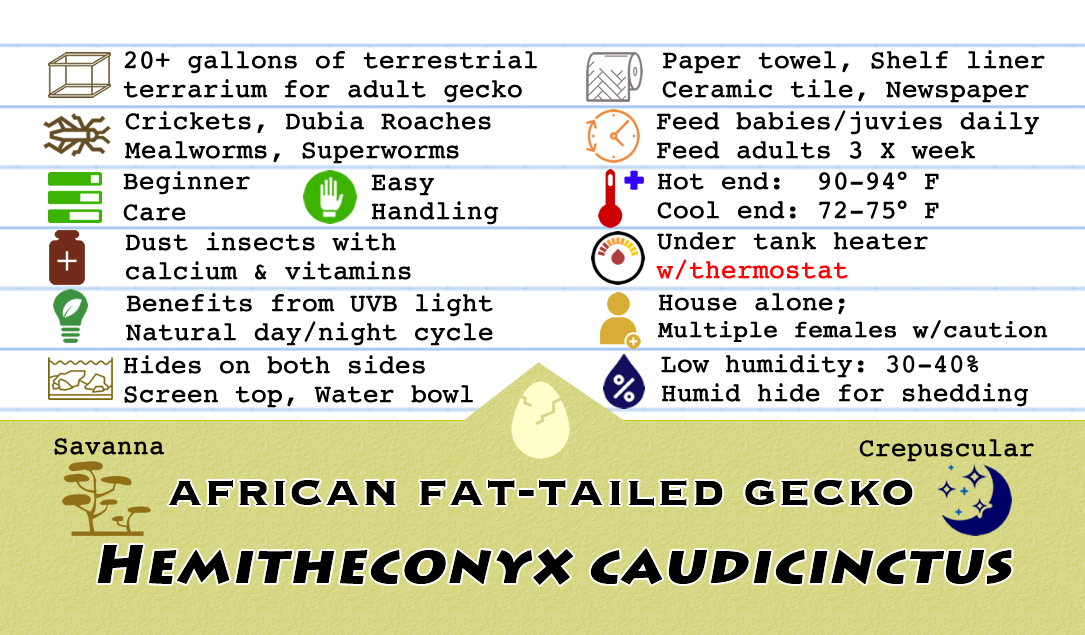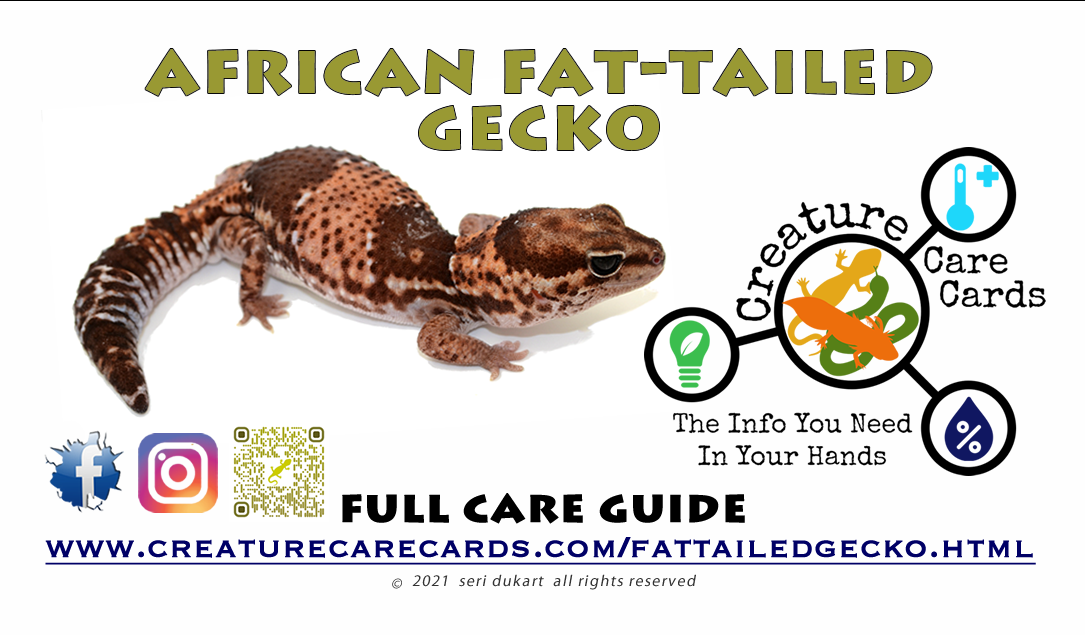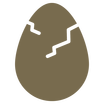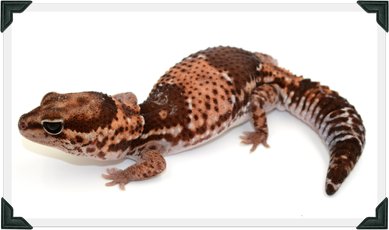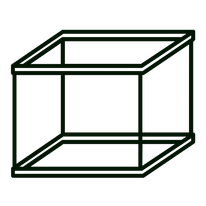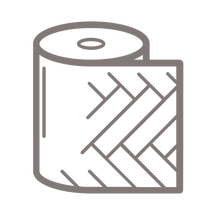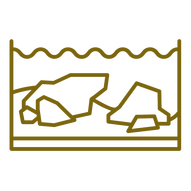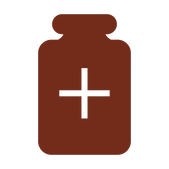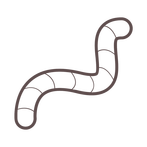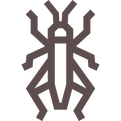Hemitheconyx caudicinctus - African Fat-Tailed Gecko
African Fat-Tailed geckos are a small, sturdy gecko that come in a variety of morphs. They are found in the savanna and scrublands and are a terrestrial crepuscular gecko, meaning they are most active at dusk and dawn.
|
Bringing Home Your New Pet
When you bring your new gecko home, you should already have a quarantine tank set up and ready to go. Place fresh water in a bowl in the tank, mist the tank and offer food, but be aware it is completely normal for them to refuse food for the first couple days, or even longer. You should keep this new gecko separate from any other geckos you may have for 90 days, to ensure there is nothing it could spread to your other animals. Monitor its eating and fecals as they may be strange for up to a couple weeks, but this is due to a new diet, supplements, and environment. It is recommended you do not handle your new gecko for the first 24-48 hours and keeping it to a minimum until it has started eating on its own. Always keep in mind, your new animal is in a new tank, with new decor/dishes/hides, and new faces watching them. They need time to become acclimated to it all. After this quarantine process, they can be safely introduced to their permanent enclosure if it's not already. Be sure to wash your hands before handling any other geckos during this time. |
|
Enclosure Depending on your need, there are a couple different ways to house a fat-tailed gecko. For the single gecko owner, an aquarium would be the most appealing. The general rule of thumb is to have 10 gallons of tank per juvenile gecko. Adults do well in a 20 gallon long. More space is always better. The second way to house is a rack system with tubs, most commonly used by breeders to use their space most efficiently. While fat-tailed geckos are terrestrial, they can climb so it is best to have a screen lid on the tank to protect them from other pets in the household and to prevent escape. |
|
Substrate
Fat-tailed geckos thrive best on simple substrates such as paper towel, reptile carpet, newspaper, or tile. They should never be housed on sand of any kind, as they will ingest it causing impaction and, if not caught early enough, will cause death. For those of you looking for the naturalistic enclosure, I would recommend tile, which comes in many colors and styles at your local hardware store. For those who prefer easy cleaning, paper towels are recommended. Female fat-tailed geckos can lay eggs when they reach breeding age, even if they were never with a male. It is best to provide all female geckos with a lay box with loose substrate for them to lay their eggs and prevent egg binding. |
|
Compatibility
Geckos by nature are solitary animals. In fat-tailed geckos, females can be housed together with caution. They must be of the same size to prevent bullying. If you do choose to house more than one gecko together, more space is needed, with an additional 10 gallons of floor space per additional gecko. Adding more hides and decor will help prevent fighting. Males will fight with one another, and geckos of different sizes will bully and attack one another. Do not house males and females together unless you have researched breeding and are prepared for eggs and babies. Monitor females to be sure they are not picking on one another or one is not hoarding the food from the other. |
|
Heating
Fat-tailed geckos are cold blooded, so they rely on their environment to regulate body temperature. It is important that the temperature be around 90-94 on one side of the tank, while the other side of the tank be in the upper 70s or lower 80s so the gecko can thermoregulate by moving from one side of the tank to the other. The heat source should come from below the enclosure to aid in digestion. So with a glass enclosure, an under tank heater is best, but for a rack system, heat tape with a thermostat is most efficient.
|
|
Lighting
Fat-tailed geckos are crepuscular, meaning they are active at dusk and dawn. They should be exposed to 10-12 hours of light per day. UVB lighting is beneficial and is highly recommended to thrive. Be sure all lights are on a timer to offer a natural day and night light cycle. |
|
Cage Decor
Since they are crepuscular, they need to have places to hide from the daylight to sleep. These hides can be as fancy as you prefer, from something store bought to an overturned plastic container with a door cut out. There should be at least 2 hides, one on the cool side which should be kept moist to aide in shedding, and another should be kept on the warm side. The moist hide can be kept damp with wet down paper towels or sphagnum moss. Low branches, rocks, cork pieces and fake plants can be added to the tank for visual appeal and for your gecko to explore! |
|
Humidity and Shedding
Fat-tailed geckos are a savanna and scrublands species, so they do not require high humidity. Access to the moist hide mentioned in decor to help them aid in shedding will keep the humidity level at an appropriate level without additional efforts. If your fat-tailed gecko is showing signs of stuck shed, you can mist the tank lightly to bring the humidity level up. Fat-tailed geckos will shed their skin about every 3-4 weeks. You’ll notice their color will appear dull when they are about to shed. It is important to have this moist hide in their enclosure to aid in the shedding process. Generally, the gecko will eat all of their shed, but you may see some of the shed skin in the cage. Some geckos will have unshed skin on their toes, we suggest letting your gecko soak in a shallow container of luke warm water for a few minutes and you can assist the process by gently removing the skin using tweezers. |
|
Supplements/Minerals
To ensure proper bone development and overall health, a shallow dish of calcium powder should be kept in the enclosure at all times. You can also dust feeder insects in powder before feeding to ensure they are getting the calcium they need. Once a week, dust insects in a supplement vitamin powder instead of calcium. |
|
Feeding Fat-tailed geckos are insectivores. Typically, their diet consists of crickets and/or mealworms. Other insects like dubia roaches and superworms are acceptable as well. Waxworms, phoenix worms, and horned worms can be given as well, but should not be a staple, as they are not high in nutritional value. Crickets can be placed in the enclosure during feeding time, but uneaten crickets should always be removed. Mealworms can be kept in a shallow dish. Fat-tailed geckos can be a bit pickier than leopard geckos when it comes to insects. Many keepers report better growth rates and eating habits with crickets over mealworms. Insects should be gutloaded with a commercial gutload product. Gutloading refers to the practice of feeding the insects a nutritious diet before offering them to your gecko, to ensure the most balanced nutrition. Geckos that are under 4 months old should be fed daily, about 5 small crickets or mealworms. Juveniles and adults should be fed 9 crickets or mealworms three times a week. |
|
Handling
Fat-tailed geckos are usually open to being handled and with regular contact, can become very tame. Sit on the floor and let your gecko walk from hand to hand at their own pace. When handling your gecko, never hold or grab them by their tail. They have a natural ability to drop their tail as a defense mechanism. If this does happen, they will regrow their tail, but it will look different than before. |
|
Shopping List with links to tried and true products
*optional |
